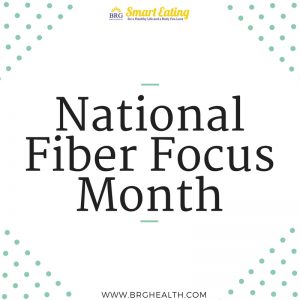Stay Focused on Fiber This Month
 January is National Fiber Focus Month. What better way to start the New Year than to learn about the benefits of fiber and how you can eat more fiber!
January is National Fiber Focus Month. What better way to start the New Year than to learn about the benefits of fiber and how you can eat more fiber!
Fiber is a form of carbohydrate, also known as roughage or bulk. It comes from starch from plant and your body cannot break it down into usable energy for your body. Instead, fiber helps regulate bowel movements, decrease blood glucose and cholesterol levels, and increase satiety, thus regulating weight.
Types of Fiber
There are two types of fiber, insoluble and soluble fiber. Most foods contain a mix of the two types of fiber, but it will depend on the food.
- Insoluble fiber’s job is to keep your intestinal tract healthy by attracting water to the intestine, softening your stool. It will also reduce the amount of time that food sits in your intestinal tract. You want this to happen because if food sits there too long it can cause constipation. Food sources: wheat bran, whole grains, fruits and vegetables.
- Soluble fiber’s job is to also soften stool and ferment in the intestines to produce healthy gut bacteria. This enhances your immune system to fight infection and chronic disease. Soluble fiber also aids in lowering your blood cholesterol by reducing the amount of dietary cholesterol your body absorbs. Food sources: dried beans, peas, lentils, oats, barley, fruits, and vegetables like carrots and squash.
Eat More Fiber
The National Fiber Council recommends 32 grams of fiber a day for a healthy adult. However, according to Columbia University Institute of Human Nutrition, the average American barely consumes half of the recommended amount of fiber needed per day. This needs to change!
Here are 6 ways you can add more fiber to your day!
- Start your day off with a high-fiber breakfast. This can be oatmeal with fresh berries, whole-wheat toast and peanut butter or a high-fiber cereal with fruit.
- Choose legumes. Legumes, such as beans and peas, are high in soluble fiber and are a good source of protein. Try swapping out a hamburger for a black bean burger at dinner.
- Keep the skin on fruits and vegetables. Most of the fiber found in foods is found on the skin, yet you may peel it off. Avoid peeling the skin off of apples and potatoes to keep the fiber content high!
- Eat more fruits and vegetables. Fruits and vegetables are excellent sources of fiber. Opt for whole fruits and veggies vs. juice to benefit from all the fiber found naturally! Banana and peanut butter on whole-wheat toast makes for a great high-fiber snack.
- Swap iceberg lettuce for romaine lettuce or spinach. Salads are a lunch favorite, but if you choose a salad with a base of iceberg lettuce you are missing out on fiber. Instead, choose romaine lettuce, spinach or kale as your salad base for more fiber. You can also pile on beans and vegetables for even more!
- Make whole grain and whole-wheat your first choice. Whole grain and 100% whole-wheat pasta, breads, etc. are high in fiber. Since they are minimally processed, they retain the bran, which contains all of the fiber (unlike white pastas and breads).
If eating high-fiber foods is new for you, then add fiber slowly into your diet. Start by adding one fiber-rich food daily for one week, and then increase to two until you meet the recommendation. It is also important you increase the amount of water you drink to prevent constipation!! Once your body gets used to eating more fiber you won’t have to think twice.
Your Turn to Take Action: How will you eat more fiber this month? Let me know in the comments below!


Leave a Reply
Want to join the discussion?Feel free to contribute!